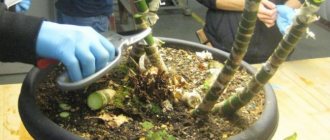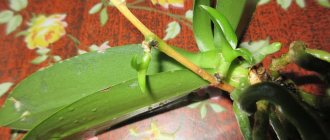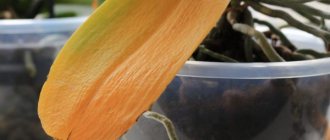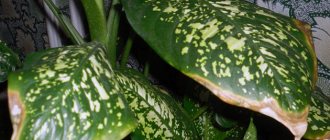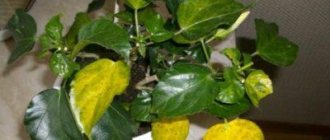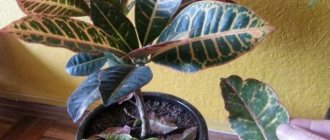Damage to a flower from the inside
Rotting from the inside is the most severe form of damage. It is not always possible to determine in time that a cactus is rotting from the inside. Most often, such plants die (you can find out what can cause the death of a cactus and how to understand that a plant is dying here, and from this article you will learn how to save a plant).
Signs
On the body of the plant, small, slowly increasing spots are found, light or dark, depending on the type of disease (what diseases and pests can destroy the plant?). At the same time, internal damage significantly exceeds that visible on the outer surface. When you press on the affected area, you feel a softening of the body.
Why is this happening?
The main reasons why cacti rot from the inside may be the following.
Dry rot (fomoz). This is a fungal disease. The causative agent is the fungus Phoma rostrupin. The most dangerous because it is difficult to detect. Dry, light, slightly depressed spots resembling crusts appear on the plant. The spots themselves are covered with cracks. After pressing, the crust falls into a cavity in which all the internal tissues are turned into a dry mess.- Brown rot. The causative agent is pathogenic bacteria from the genus Erwinia. Foci of dark brown or brown color appear, primarily between the ribs of the cactus. The trunk of the plant softens and darkens.
- Rhizoctoniosis. Occurs as a result of infection with pathogenic fungi of the genus Rhizoctonia. Crops are mainly affected. The pathogen spreads through the feeding vessels inside the body of the cactus, causing wet rotting.
- Black rot (Alternaria blight). Caused by the fungi Alternaria radicina. Moist and shiny brown spots are found on the body of the plant. The disease progresses rapidly.
- High humidity in the room where the plant is kept. More often, excess moisture causes rotting of the roots and neck of the cactus, but it can also lead to rotting of the plant from the inside.
How to save?
When detecting areas of rotting on a plant, first of all, it is necessary to assess the depth of the lesions. To do this, the cactus is removed from the substrate, carefully examined and palpated.
- If the pathological lesions are not large, they are cut out to healthy tissue. The resulting wounds are treated with sulfur, coal or brilliant green. The cactus is dried for several days and planted in fresh soil (sand is best).
- If the body of the cactus is very soft and rotting is widespread along its entire perimeter, then cut off and leave only the healthy tip. It is dried and rooted, or grafted onto another cactus (read more about what to do if the cactus has become soft).
Common Cactus Diseases
The cause of cactus disease is protozoan microorganisms. Most often they are affected by various rots and spots. They are also susceptible to viral infections. Frequent guests of succulents are: mosaic, jaundice, witches' brooms.
The cactus, despite its thorns, can also hurt
Dry rot
One of the most formidable enemies of succulents are various rots. It is difficult to immediately understand why the cactus rotted. Different microorganisms cause different forms. It depends on them what kind of rot will affect the plant - root, stem, dry or wet.
The most dangerous is dry rot on a cactus. The cause of the disease is mold fungi. It is very fleeting and almost asymptomatic. A cactus can dry without changing color or shape. If you break such a plant, it will be completely dry inside. Changes in flower development can only be noticed by very experienced gardeners. Since it is very difficult to understand that a cactus has dried up. It is usually too late to save the succulent.
It is believed that the causative agent of the disease enters through wounds on the skin of the plant. At the same time, it can live inside for a long time and will begin destructive development only in weakened areas of the crown.
If the root of a cactus has rotted, what should you do to save it? Quarterly treatment with any fungicide will help save the plant.
Falling off of thorns
Baldness of a cactus occurs when the watering regime is violated. The root system suffers greatly from standing water. Often, because of this, the plant stops receiving the required amount of nutrition and its spines begin to fall off. Especially in winter, waterlogging is contraindicated. It is better to keep the succulent cool during the dormant period and completely “forget” the flower.
In the summer, you should wait until the soil in the pot dries completely and only then water it. Excess water from the pan must be drained.
What to do if the cactus begins to rot
Only timely replanting with revision of the root system will help save the succulent. In the future, you must strictly adhere to the rules of content.
Sometimes the plant is shed by pests (spider mites, scale insects). Insects suck the juices from the pulp of the cactus, which leads to growth stagnation, flowering cessation, and thorns falling off. As a result, the stem may simply fall.
spotting
Spots on the surface of the above-ground part of the succulent are associated with a violation of the maintenance conditions. Due to constant drafts, extreme temperature drops, in combination with high humidity, the integrity of the cactus skin is compromised.
These areas become the object of interest for all kinds of viruses and pathogenic bacteria. Their vital activity contributes to the growth of spots. Eventually the stem becomes completely black and this leads to the death of the flower.
If any stains are detected, it is recommended to provide the flower with comfortable conditions:
- move the pot to a warm, dry place without drafts;
- protect (shade) from direct sunlight;
- water with warm water;
- drain the water from the pan.
Mold
Gray mold is dangerous for young seedlings. The seeds become infected with it, and then the disease is transmitted to the young shoots. To prevent crop death, seeds should be treated with a fungicide.
If not properly cared for, various plaques resembling mold may appear on the plant. There is reason to worry. This is a signal and rescue measures are required.
The cause of white mold is Powdery Mildew. The causative agents of the disease are exoparasitic fungi. The plaque is nothing more than their mycelium. Pathogenic crops feed on plant juices, multiply intensively and conquer more and more area. As a result, the entire surface of the stem turns into solid felt. With the complete disruption of photosynthesis, the development of the succulent also stops. He dies.
Need to know! The course of the disease is very similar to the symptoms of peronosporosis (downy mildew). With this disease, the spots are reddish-brown. The treatment for these two lesions is different!
Dangerous fungi are always present in the natural flora of a succulent. They are activated only when the plant’s immunity is weakened. This is caused by the following violations of flower maintenance conditions:
- temperature violation;
- very humid air;
- flower overflow;
- oversaturation of soil with nitrogen.
If a lesion is detected, the flower must be isolated immediately. Inspect neighboring plants and carry out preventive measures. Without correcting the care conditions, the flower will not survive.
If the damage is severe, the flower must be replanted in fresh soil. Before this, you need to trim off all affected areas. Otherwise, it may rot again.
If the extent of the disease is insignificant, you can try folk remedies:
- Soap and soda solution. For three days, the flower is sprayed with a solution of 1 tablespoon of soda and the same amount of grated laundry soap in 1 liter of boiled water. It is enough to treat once a day.
- Spraying with a pale pink solution of manganese (3-4 crystals of permanganate in 1 liter of water). Treatment is carried out three times, with breaks of 3 days.
- Treating the plant and soil with diluted mustard powder. To do this, dilute 0.5 teaspoons of dry powder in 1 liter of water.
- Using copper sulfate with laundry soap. The solution is prepared from 5 g of copper sulfate, 10-15 g of liquid laundry soap in 200 ml of water.
Important! First of all, vitriol is diluted in water. Then, with constant stirring, soap is added.
If pathogenic flora has occupied large areas, it is better to use fungicides. There are a lot of them. Flower growers prefer such as topaz and foundation. They are bred in accordance with the instructions. Practice shows that 3-4 treatments are sufficient.
It is best to prevent illness, that is, take preventive measures. Feeding with minerals will help increase the flower's resistance to diseases. Phosphorus and potassium fertilizers are very welcome. At the same time, it won’t hurt to pollinate the bushes with sulfur and spray with diluted milk (proportions 1:3). It is enough to carry out treatments once a month and only in the summer.
Mealybug
If ragged cotton islands appear on the surface of the flower, then a mealybug has become its guest. Unlike powdery mildew, this parasite destroys all parts of the plant.
The scale insect can be seen with the naked eye. On the surface of the succulent there are large females, very fertile and capable of reproducing without a male.
Like many other pests, they feed on plant sap. At the same time, a toxic sticky liquid is left on the flower, which is very attractive to sooty fungus. Secondary infection occurs, resulting in:
- the ground part of the cactus becomes sluggish;
- the stems become deformed, turn yellow, and wither;
- the plant stops growing;
- ovaries and buds dry out and fall off;
- the flower's skin cracks.
What to do when the cactus becomes soft and watery
At the very beginning of the lesion, you can cure the cactus with a soap solution (1 teaspoon per liter of boiling water). This composition should be used to clean the insects themselves, masonry, and honeydew nectar from the shoots. Severely affected parts of the plant are pruned. You can first clean the flower under a warm shower.
Is it possible to save if it starts to hurt from below, at the base?
As a result of improper care, the roots and base of the cactus are affected and rotting processes develop. This is the most common form of damage to this plant species. Fortunately, there is a chance to save the diseased cactus.
How to detect?
Damage to the roots and neck of a cactus can be detected by the following signs:
- a rim of brown or brown color in the lower part of the plant, at the border with the ground;
- the cactus falls to the side and is poorly kept in the ground;
- in advanced cases, the plant falls due to severe damage to the root system.
Source of infection
Cactus late blight (late blight, black root stalk). A disease caused by fungi of the genus Phytophtora. The roots of the plant and the base of the stem are affected.- Helminthosporosis. Another disease of fungal etiology. The causative agent is Helminthosporium cactivorum. Watery, dark brown lesions are found in the neck area of the cactus. Mostly young plants are infected.
- Excessive watering. The cactus loves dry soils and if there is too much moisture, the root system begins to rot very quickly.
- Improperly organized wintering. During the cold season, cacti need to have a dormant period, during which the plant is provided with a large amount of light and a minimum of moisture.
The temperature in the room with the plant should be +12..15°C. In case of any deviations from the required conditions, the cactus is susceptible to various diseases, including rotting. - Lack of moisture. Combined with elevated air temperatures and intense lighting, insufficient watering can cause root rot.
What to do with a rotten plant?
The answer to the question of what to do if the root of a cactus has rotted, how to save a rotten flower, and whether it can be revived, in this case is unambiguous. The plant is freed from soil, the roots are thoroughly washed and the degree of damage is determined. All areas infected with rot are removed with a small margin, since fungal infections can spread to healthy tissue. The sections are treated with fungicides (sulfur, copper sulfate). After pruning, the cactus is dried and planted in dry sand. Watering is carried out through a tray, rarely and in small quantities. In such conditions, the plant is kept until rooting.
What to do when rehabilitating the roots of a cactus when rotting
Under natural conditions, cacti have adapted to survive in the heat and easily tolerate drought and sudden temperature changes. But even these plants can experience root rot. This is a consequence of excess moisture, caused by improper care and unsuitable conditions for maintenance. Cacti suffer from pests, viruses, infections and lack of sunlight. Often, infection begins from the bottom, and the owner notices late that the roots of the cactus have rotted and needs to be saved.
Dry rot
It is quite difficult to identify this disease. usually discovered when the cactus is in its “death” stage.
What to look for during inspection?
When infected by Phoma rostrupin fungi, the plant turns pale and begins to dry out. Most often this goes unnoticed. Then dry crusts covered with cracks appear on the body of the cactus, and when pressed, your finger falls into the trunk. If the stem is cut, the cactus turns out to be empty, dried out inside.
Prerequisites for the disease
Introduction of the Phoma pathogen through wounds on the trunk of a cactus. When replanting or transporting a plant, you can accidentally damage the integrity of its body. In such cases, the fungus penetrates through the damaged areas, and the cactus becomes infected.- Violation of wintering conditions. If wintering is not organized correctly, the cactus’s resistance to infectious diseases decreases.
- Excessive watering. Excess moisture causes rotting of the root system, which weakens the plant's resistance to infectious diseases.
- Vaccination with a sick cactus. Only healthy plants should be grafted.
- Replanting into soil previously used for another plant. If a cactus suffering from dry rot previously grew in the soil, such a substrate should be destroyed and under no circumstances used for other plantings.
Can anything be done?
No effective methods have been developed to combat dry rot. The disease develops quickly and ends in the death of the cactus. To prevent this disease, plants should be treated quarterly with fungicides, and the conditions for keeping cacti and their wintering should be observed.
Causes of cactus diseases
Desert-dwelling succulents are adapted to survive in extreme conditions. But they react negatively to excess moisture, especially when the room is cold. Novice gardeners often make mistakes in care and maintenance.
Often the cause of rotting is an unsuitable substrate. To grow cacti, it is recommended to purchase light soil consisting of small stones, garden soil and sand. Peat and black soil are not suitable for these plants. Such soil will not dry out well, does not allow the roots to breathe freely and provokes the development of bacteria in the substrate.
Varieties of cacti that naturally grow in the desert can survive for up to six months without watering. Then the plant begins to receive moisture from the air. If you do not water forest varieties of cacti, they quickly lose their natural color, their leaves fall off, and their stems begin to wither.
Excess water is no less dangerous for all parts of the plant. This can be seen by the loss of ribbing. Its thick stem swells, becomes covered with spots, the needles become soft and fall out. If you press on the plant, the skin easily comes off from under it and juice begins to ooze. This indicates the onset of a fungal infection with rotting roots.
During the rest period, it is recommended to reduce the room temperature to 8 to 12 degrees. During this period, the amount of watering is reduced. For desert varieties of cactus, a watering regime of once every 30 days is suitable. Forest species are recommended to be watered more often: once every 10–15 days. If a cactus is left on a balcony or in another cold place with a temperature below zero for at least a day, it can recover, and the roots will begin to die.
Pests and fungal diseases that attack indoor flowers are also dangerous for succulents. The roots and stems of the cactus are affected by late blight, black root stalk. No less common is helminthosporiosis, which affects young plants in the neck area. Diseases are provoked by excess moisture and improperly organized wintering for the succulent. In winter, cacti need a lot of light, a decrease in room temperature and a minimum of moisture. If there is a lack of moisture or high temperature in the room during the dormant period, the root system may also rot.
How to resuscitate when a flower is completely damaged?
It also happens that people go on vacation, entrusting their “green hedgehog” to the care of a neighbor, and upon returning they find their pet in a terrible state, rotten to the very top.
What are the chances of rehabilitation?
If most of the plant has undergone rotting processes, it is impossible to revive it; such a cactus simply does not have enough strength to take root.
If the top has survived, you can try to root it. For this:
- the healthy part is cut off and dried in an upright position for several days;
- the cut site must be treated with coal or sulfur;
- then the surviving part is planted in dry soil with infrequent watering until roots appear.
The cactus cannot be called capricious, but it also requires care and attention from the gardener. Read articles from our experts about why the plant turns yellow, stretches out or leans to the side, and also how to rid the flower of white bloom.
External signs of rotting cactus roots
If the plant has acquired a pale tint or turned yellow, or the stem has stopped shining, this indicates rot. The same phenomenon occurs when a succulent shrinks. Signs when the watering regime is normal and the plant has entered the vegetative phase. A bad sign is a stem tilting to one side. A healthy plant should not have spots of any etiology or texture (dry, wet, brown or bright). A dent on the left or right, closer to the top of the cactus, also indicates rotting.
If the plant does not grow in season, this is a bad sign and indicates a serious disease. For a number of exotics, “wintering” with rest in summer is considered acceptable. Such cacti include rebutia and ailostera. A constantly wet substrate that does not dry out after watering for a long time indicates problems with the roots.
You can compare the drying period of the soil by placing several containers with plants nearby and watering them at the same time. Often the onset of rotting occurs unnoticed, but it can be identified by the appearance of a dark-colored rim at the bottom of the thick stem. If the roots are damaged, the plant does not sit tightly in the ground and may bend or fall to the ground.
How to care?
Cactus is a plant that does not require special attention. However, certain rules must be followed to avoid infection with rot.
- This plant requires a lot of light; the cactus should be placed on or near a windowsill.
- The cactus should be watered as needed, adhering to the principle “the warmer the room, the more abundant the watering,” but not more than once every 2 days.
- During the dormant period, water the cactus once every 1.5-2 weeks, monitor the temperature and lighting in the room.
Caring for a cactus should be approached carefully and responsibly, although it does not require as much effort as other indoor plants. With the right approach, the cactus will delight its caring owners for many decades.
Further care of the cactus
After the cactus has recovered, it is necessary to change the conditions of its maintenance. To prevent the disease from returning, you should provide it with optimal temperature, humidity, and watering conditions.
Temperature and humidity
Cacti are desert dwellers. Very sensitive to the amount of solar heat and light. But in the midday sun they can easily get sunburned. When keeping at home, you need to take this fact into account.
Humidity for succulents is sufficient within 40-50%. The temperature during the dormant period is no more than 15-18 °C (they can tolerate short-term drops of up to +5 °C); during the active growing season, the optimal temperature will be 26-28 °C.
Soil and watering
The soil for succulents needs light, loose, slightly acidic. Desirable compositions include sand, peat and charcoal. A high drainage layer is very important. Without it, even a healthy plant can rot. For this purpose: expanded clay, pebbles, broken bricks are used.
In winter, watering is very scarce. It is enough to moisten the soil once every 2-3 weeks. During the warm season, succulents need frequent and abundant watering. Depending on the dryness of the soil surface, 2-4 times a week. Watering is carried out through a tray. After 20-30 minutes, excess water is drained.
Important! Water for irrigation is used that is settled and warm.
Diseases of cacti and their treatment have been widely studied around the world. Although most varieties have very good immunity, if the maintenance rules are violated, they can get sick. To make your pet happy all year round, you should take care of it. To do this, you need to regularly inspect the bush, carry out preventive procedures and treat if necessary.
Help the plant
After identifying rot, the plant owner needs to understand the cause of the processes. Based on this, a decision is made on the method of treating the succulent. In case of minor damage, it is enough to treat and transplant the plant into a new container and soil.
Apex transplantation
If the roots of a cactus are severely rotting, the only way to help it is to root the top. The damaged area is cut off, the cut is cleaned with a knife and treated with activated carbon powder. The stem is sharpened like a pencil. So, it is easier to plant it in the ground. Experienced gardeners recommend covering the stem with thorns with a thick cloth to avoid injury while processing the plant.
After the procedure, the cactus is dried and strengthened on a support, for example, on a glass. It should grow new roots within 10–30 days. After this, the plant is transplanted into prepared soil. During the procedure, you should be careful not to damage the delicate sprouts. Then watering is carried out through the pan, the remaining water is drained after ten minutes. The succulent is watered a second time 20–25 days after the first. This will prevent repeated rotting of the root system.
Treatment of cacti without external signs of rotting
Watering the succulent completely stops, as does spraying. The affected areas of the cactus are excised and dried for several days. After this, the plant is removed from the soil and the roots are examined. If there is nothing left of the root system, then the crown is immediately rooted. Healthy roots have a gray-green tint. They do not crumble when touched, do not bend or break. When affected by a fungus, crimson and brown spots appear on the root shoots.
The next step is to trim all damaged areas using a disinfected scalpel. Cut off the affected shoots until the sections become white, clean and without inclusions or spots. If the rotting process has gone above the root collar, and there are still spots, then continue pruning in even thin layers. The final cut is made with a clean tool and the bottom is sharpened like a pencil. Otherwise, it will be difficult for the succulent to take root. The remaining operations are performed as when rooting the crown.
Sampling
Natural change in cactus tissue at the bottom of the stem. The rough yellowish layer improves the mechanical stability of the massive plant. The defect is hidden under the soil by adding fresh soil mixture.
Kidney abscission
Leaf-like cacti shed buds when there is a lack of water, excess nitrogen and dry air. If the plant has set flowers, then the position of the pot cannot be changed. Early exit from wintering and abundant irrigation provokes the problem.
Burns
After winter, you should not place cacti in very bright sun. The crop becomes unaccustomed to ultraviolet radiation, so intense radiation causes burns. Pale yellow marks on fabrics remain forever.
Chlorosis
The destruction of chlorophyll in plant stems appears in the form of light spots. The problem occurs when there is a deficiency of magnesium and iron in the substrate. To prevent spread, you need to feed with complex fertilizer.
No growth
Cacti develop during spring and summer. Lack of irrigation, depleted soil and nutrient deficiency will make awakening impossible. If the culture has not started to grow, then care needs to be reconsidered.
Pests
The cactus may break, dry out or darken due to harmful insects. Let's look at the most dangerous of them.
Mealbug
Mealybugs are small insects covered with fine white hair. They quickly move from plant to plant.
These pests feed on succulent sap. In addition, a sooty fungus settles on their secretions. The affected plant begins to wither and lag behind in development, new shoots may decrease.
The cactus needs to be treated with a soap-alcohol solution (1 teaspoon of soap and 2 tablespoons of alcohol per 1 liter of water) to remove the protective coating on the parasites. Then visible insects need to be removed with a cotton swab and, finally, the cactus should be sprayed with an insecticide (Fitoverm, Aktara, etc.).
Spider mite
Typically, ticks start due to too hot, dry air. Most often, fleshy varieties suffer from it: rebutia, echinopsis, etc.
These tiny (up to 0.25 mm) insects pierce the skin of the plant to feed on its sap. The damaged areas dry out and turn yellow, gradually merging into a brown shiny spot. The top suffers the most.
The cactus should be treated with Karbofos, an ether sulfonate solution or a decoction of cyclamen tubers. You can also wipe the plant with soapy water, alcohol or garlic infusion.
Since many products will only kill larvae or adult ticks, treatments must be carried out several times.
Symptomatic therapy
Symptomatic therapy is aimed at eliminating certain symptoms of the disease and alleviating the general condition of the animal: it includes the use of antispasmodics, drugs that protect the liver, antiemetics, anticonvulsants and cardiac drugs. The dog is placed in a warm room, and if dehydration develops, balanced solutions (lactated Ringer's solutions, glucose solutions), and vitamins are administered intravenously.
When treating leptospirosis, diet therapy is no less important. During the period of illness and after it, dogs should be fed food with a low protein content, and in the case of icteric form - with a low fat content.

